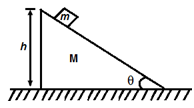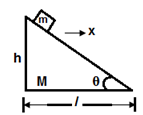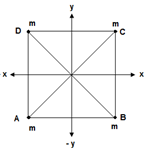12th Grade > Physics
CENTER OF MASS MCQs
Total Questions : 30
| Page 1 of 3 pages
Answer: Option A. -> (1,75)
:
A
The (x, y) co - ordinates of masses 1 kg, 2kg, 3kg and 4kg respectively are
(x1=0,y1=0),(x2=2m,y2=0),(x3=2m,y3=2m),(x4=0,y4=2m).
The (x, y) co-ordinates of the centre of mass are
xCM=1kg×0+2kg×2m+3kg×2m+4kg×01kg+2kg+3kg+4kg=1m
yCM=1kg×0+2kg×0+3kg×2m+4kg×2m1kg+2kg+3kg+4kg=75m
:
A
The (x, y) co - ordinates of masses 1 kg, 2kg, 3kg and 4kg respectively are
(x1=0,y1=0),(x2=2m,y2=0),(x3=2m,y3=2m),(x4=0,y4=2m).
The (x, y) co-ordinates of the centre of mass are
xCM=1kg×0+2kg×2m+3kg×2m+4kg×01kg+2kg+3kg+4kg=1m
yCM=1kg×0+2kg×0+3kg×2m+4kg×2m1kg+2kg+3kg+4kg=75m
Answer: Option C. -> ml−mlcosθM+2m
:
C
Let wedge move towards right by distance x; then
ΔxCM=m(lcosθ+x)+Mx+m(x−l)m+M+m
0=mlcosθ−ml+(m+M+m)x
x=ml−mlcosθ2m+M
:
C
Let wedge move towards right by distance x; then
ΔxCM=m(lcosθ+x)+Mx+m(x−l)m+M+m
0=mlcosθ−ml+(m+M+m)x
x=ml−mlcosθ2m+M
Answer: Option B. -> 12m1m2m1+m2(v1−v2)2
:
B
K=12m1v21c+12m2v22c …… (i)
Where v1c and v2c are velocities relative to the CM.
v1c=v1−vCM=v1−(m1v1+m2v2m1+m2)=(m2(v1−v2)m1+m2)
v2c=v2−vCM=v2−(m1v1+m2v2m1+m2)=(m1(v2−v1)m1+m2)
Putting these in Equation (i), K=12m1m2(m1+m2)(v1−v2)2
Note: For a system of two particles of masses m1 and m2, the total kinetic energy isk=(1/2)μv2+(1/2)(m1+m2)v2CM where μ=m1m2m1+m2 (known as reduced mass of the system and
→v=→v1−→v2 (relative velocity).
:
B
K=12m1v21c+12m2v22c …… (i)
Where v1c and v2c are velocities relative to the CM.
v1c=v1−vCM=v1−(m1v1+m2v2m1+m2)=(m2(v1−v2)m1+m2)
v2c=v2−vCM=v2−(m1v1+m2v2m1+m2)=(m1(v2−v1)m1+m2)
Putting these in Equation (i), K=12m1m2(m1+m2)(v1−v2)2
Note: For a system of two particles of masses m1 and m2, the total kinetic energy isk=(1/2)μv2+(1/2)(m1+m2)v2CM where μ=m1m2m1+m2 (known as reduced mass of the system and
→v=→v1−→v2 (relative velocity).
Question 5. Consider a rectangular plate of dimensions a×b. If the plate is considered to be made up of four rectangles of dimensions a2×b2 and we now remove one (the lower right) out of the four rectangles, find the position where the centre of mass of the remaining system will be (considering the center of the rectangular plate as the origin)
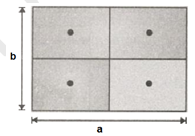

Answer: Option A. -> −a12 ,b12
:
A
The rectangular plate is shown in the figure of which one part is removed. We can find the x and y coordinates of the centre of mass of this system, taking origin at the centre of the plate. The coordinates of the three remaining rectangles are (a/4, b/4), (-a/4, +b/4) and (-a/4, -b/4). By geometry, masses of these rectangles can be taken as M/4. Now x-coordinate of the centre of mass:
xCM=Ma16−Ma16−Ma163M4=−a12
and y-coordinate of the centre of mass:
yCM=Mb16−Mb16−Mb163M4=b12
:
A
The rectangular plate is shown in the figure of which one part is removed. We can find the x and y coordinates of the centre of mass of this system, taking origin at the centre of the plate. The coordinates of the three remaining rectangles are (a/4, b/4), (-a/4, +b/4) and (-a/4, -b/4). By geometry, masses of these rectangles can be taken as M/4. Now x-coordinate of the centre of mass:
xCM=Ma16−Ma16−Ma163M4=−a12
and y-coordinate of the centre of mass:
yCM=Mb16−Mb16−Mb163M4=b12
Question 6. A 30 kg projectile moving horizontally with a velocity →v0=(120m/s)^i explodes into two fragments A and B of masses 12 kg and 18 kg, respectively. Taking point of explosion as origin and knowing that 3 s later the position of fragment A is (300, 24, –48) m, determine the position of fragment B at the same instant.
Answer: Option B. -> (400, -91, 32)
:
B
Initial coordinates of CM = (0, 0, 0)
x coordinates of CM after 3 s,
xCM=120×3=360m
y coordinates of CM after 3 s,
yCM=−12gt2=−45m
After 3 s,
(m1+m2)xCM=m1x1+m2x2
x2=30×360−12×30018=400m
Similarly, (m1+m2)yCM=m1y1+m2y2
−30×45=12×24+18×y2
y2=−91m
and in z coordinate, m1z1+m2z2=0⇒z2=32m
:
B
Initial coordinates of CM = (0, 0, 0)
x coordinates of CM after 3 s,
xCM=120×3=360m
y coordinates of CM after 3 s,
yCM=−12gt2=−45m
After 3 s,
(m1+m2)xCM=m1x1+m2x2
x2=30×360−12×30018=400m
Similarly, (m1+m2)yCM=m1y1+m2y2
−30×45=12×24+18×y2
y2=−91m
and in z coordinate, m1z1+m2z2=0⇒z2=32m
Answer: Option A. -> 12
:
A
limx→2√x−2+√x−√2√x2−4
=limx→2(√x−2√x+2√x−2+√x−√2√x2−4)
On rationalisation -
=limx→2(1√x+2+x−2√x2−4(√x+√2))
=limx→21√x+2+limx→2√x−2x+2×1√x+√2
=12
:
A
limx→2√x−2+√x−√2√x2−4
=limx→2(√x−2√x+2√x−2+√x−√2√x2−4)
On rationalisation -
=limx→2(1√x+2+x−2√x2−4(√x+√2))
=limx→21√x+2+limx→2√x−2x+2×1√x+√2
=12
Question 8. Let there are three equal masses situated at the vertices of an equilateral triangle, as shown in figure. Now the particle A starts with a velocity v1 towards line AB, particle B starts with the velocity v2 towards line BC and particle starts with velocity v3 towards line CA. Find the displacement of the centre of mass of the three particles A, B and C after time t. What would it be the displacement of centre of mass if v1=v2=v3?
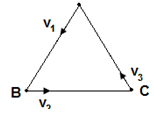

Answer: Option D. -> '0'
:
D
First we write the three velocities in vectorial form, taking right direction as positive x-axis and upwards as positive y-axis.
→v1=−12v1^i−√32v1^j
→v2=v2^i,→v3=−12v3^i+√32v3^j
Thus the velocity of centre of mass of the system is
→vCM=→v+→v2+→v33
=(v2−12v1−12v3)^i+√32(V3−V1)^j
Which can be written as→vCM=vx^i+vy^j
Δ→r=vxt^i+vxt^j
If v1=v2=v3=v, we have →vCM=0
Therefore, there is no displacement of centre of mass of the system
:
D
First we write the three velocities in vectorial form, taking right direction as positive x-axis and upwards as positive y-axis.
→v1=−12v1^i−√32v1^j
→v2=v2^i,→v3=−12v3^i+√32v3^j
Thus the velocity of centre of mass of the system is
→vCM=→v+→v2+→v33
=(v2−12v1−12v3)^i+√32(V3−V1)^j
Which can be written as→vCM=vx^i+vy^j
Δ→r=vxt^i+vxt^j
If v1=v2=v3=v, we have →vCM=0
Therefore, there is no displacement of centre of mass of the system
Answer: Option B. -> 100 m
:
B
The initial position of centre of mass is
ycm=m×0+m×402m=20m
Initial velocity of centre of mass ucm=m×50+m×302m=40ms−1
Acceleration of centre of mass, acm=−g
Using kinematics equation: v2cm=u2cm+2acmH
Here H is the maximum height reach by centre of mass of two balls from initial level.
∴ 02=402−2×10×H
⇒H=160020=80m
Hence, maximum height reach by centre of mass from ground level will be
hmax=(hcm)initial+H=20+80=100m
:
B
The initial position of centre of mass is
ycm=m×0+m×402m=20m
Initial velocity of centre of mass ucm=m×50+m×302m=40ms−1
Acceleration of centre of mass, acm=−g
Using kinematics equation: v2cm=u2cm+2acmH
Here H is the maximum height reach by centre of mass of two balls from initial level.
∴ 02=402−2×10×H
⇒H=160020=80m
Hence, maximum height reach by centre of mass from ground level will be
hmax=(hcm)initial+H=20+80=100m

